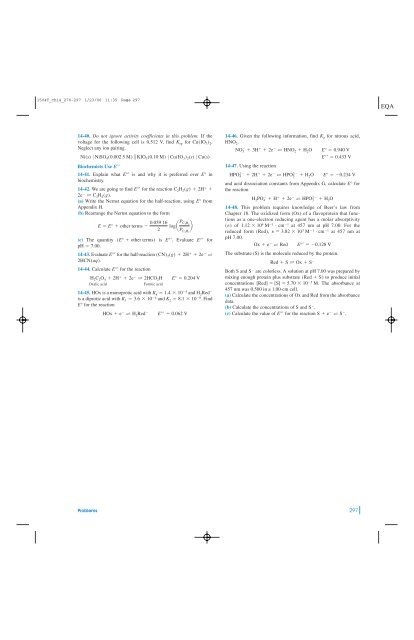Fundamentals of Electrochemistry - W.H. Freeman
Fundamentals of Electrochemistry - W.H. Freeman
Fundamentals of Electrochemistry - W.H. Freeman
Create successful ePaper yourself
Turn your PDF publications into a flip-book with our unique Google optimized e-Paper software.
1504T_ch14_270-297 1/23/06 11:35 Page 297<br />
14-40. Do not ignore activity coefficients in this problem. If the<br />
voltage for the following cell is 0.512 V, find K sp for Cu(IO 3 ) 2 .<br />
Neglect any ion pairing.<br />
Ni(s) 0 NiSO 4 (0.002 5 M) KIO 3 (0.10 M) 0 Cu(IO 3 ) 2 (s) 0 Cu(s)<br />
Biochemists Use E<br />
14-41. Explain what E°¿ is and why it is preferred over E° in<br />
biochemistry.<br />
14-42. We are going to find E°¿ for the reaction C 2 H 2 (g) 2H <br />
2e T C 2 H 4 (g).<br />
(a) Write the Nernst equation for the half-reaction, using E° from<br />
Appendix H.<br />
(b) Rearrange the Nernst equation to the form<br />
E E° other terms <br />
(c) The quantity (E° other terms) is E°¿. Evaluate E°¿ for<br />
pH 7.00.<br />
14-43. Evaluate E°¿ for the half-reaction (CN) 2 (g) 2H 2e T<br />
2HCN(aq).<br />
14-44. Calculate E°¿ for the reaction<br />
H 2 C 2 O 4 2H 2e T 2HCO 2 H E° 0.204 V<br />
Oxalic acid<br />
Formic acid<br />
14-45. HOx is a monoprotic acid with K and H 2 Red <br />
a 1.4 10 5<br />
is a diprotic acid with K and K 2 8.1 10 8 1 3.6 10 4<br />
. Find<br />
E° for the reaction<br />
HOx e T H 2 Red <br />
0.059 16<br />
2<br />
log a P C 2 H 4<br />
P C2 H 2<br />
b<br />
E°¿ 0.062 V<br />
14-46. Given the following information, find for nitrous acid,<br />
HNO 2 .<br />
NO 3 3H 2e T HNO 2 H 2 O E° 0.940 V<br />
E°¿ 0.433 V<br />
14-47. Using the reaction<br />
HPO 2 4 2H 2e T HPO 2 3 H 2 O E° 0.234 V<br />
and acid dissociation constants from Appendix G, calculate E° for<br />
the reaction<br />
H 2 PO 4 H 2e T HPO 2 3 H 2 O<br />
14-48. This problem requires knowledge <strong>of</strong> Beer’s law from<br />
Chapter 18. The oxidized form (Ox) <strong>of</strong> a flavoprotein that functions<br />
as a one-electron reducing agent has a molar absorptivity<br />
() <strong>of</strong> 1.12 10 4 M 1 cm 1 at 457 nm at pH 7.00. For the<br />
reduced form (Red), 3.82 10 3 M 1 cm 1 at 457 nm at<br />
pH 7.00.<br />
Ox e T Red E°¿ 0.128 V<br />
The substrate (S) is the molecule reduced by the protein.<br />
Red S T Ox S <br />
Both S and S are colorless. A solution at pH 7.00 was prepared by<br />
mixing enough protein plus substrate (Red S) to produce initial<br />
concentrations [Red] [S] 5.70 10 5 M. The absorbance at<br />
457 nm was 0.500 in a 1.00-cm cell.<br />
(a) Calculate the concentrations <strong>of</strong> Ox and Red from the absorbance<br />
data.<br />
(b) Calculate the concentrations <strong>of</strong> S and S .<br />
(c) Calculate the value <strong>of</strong> E°¿ for the reaction S e T S .<br />
K a<br />
Problems 297

















